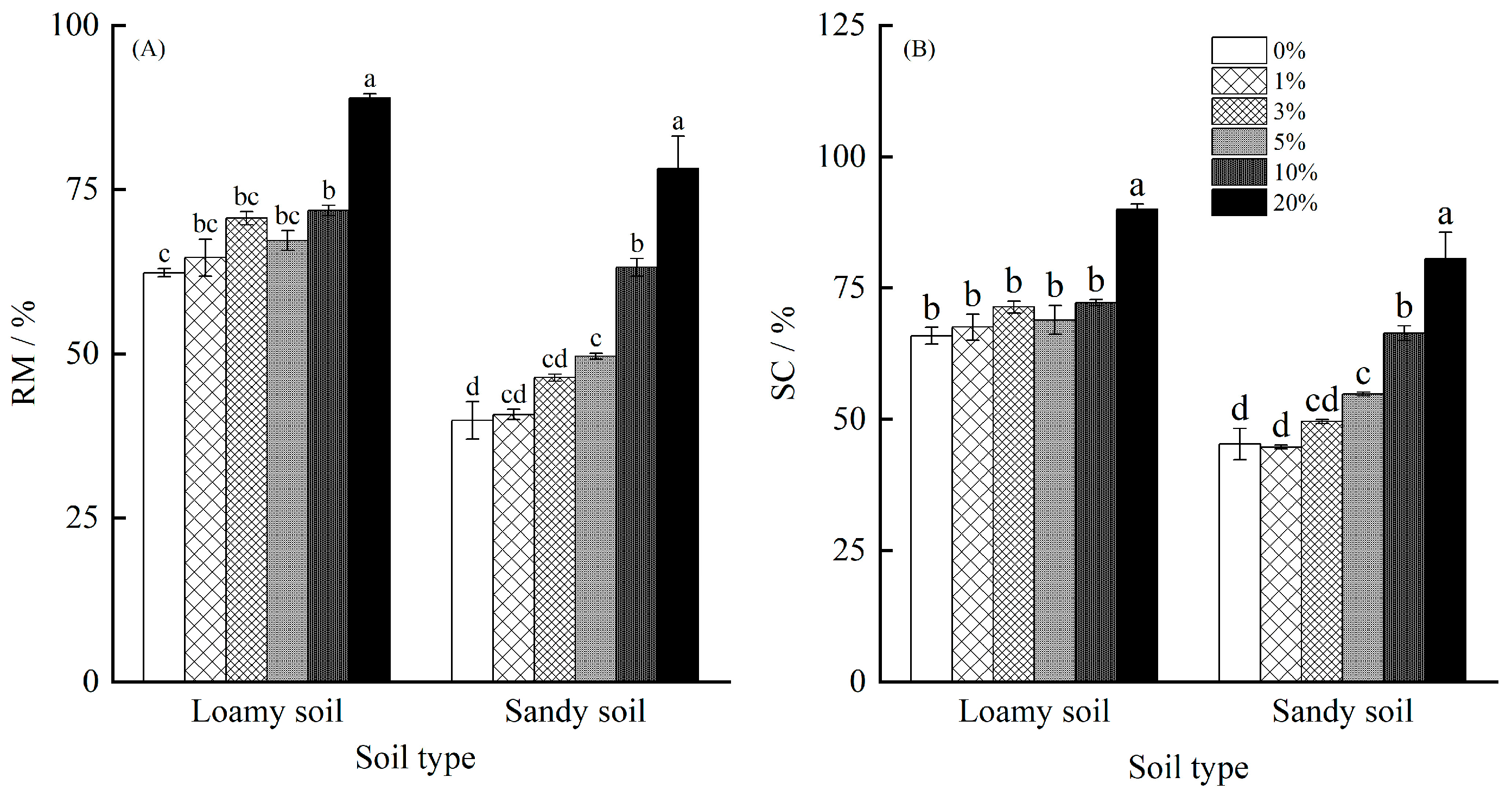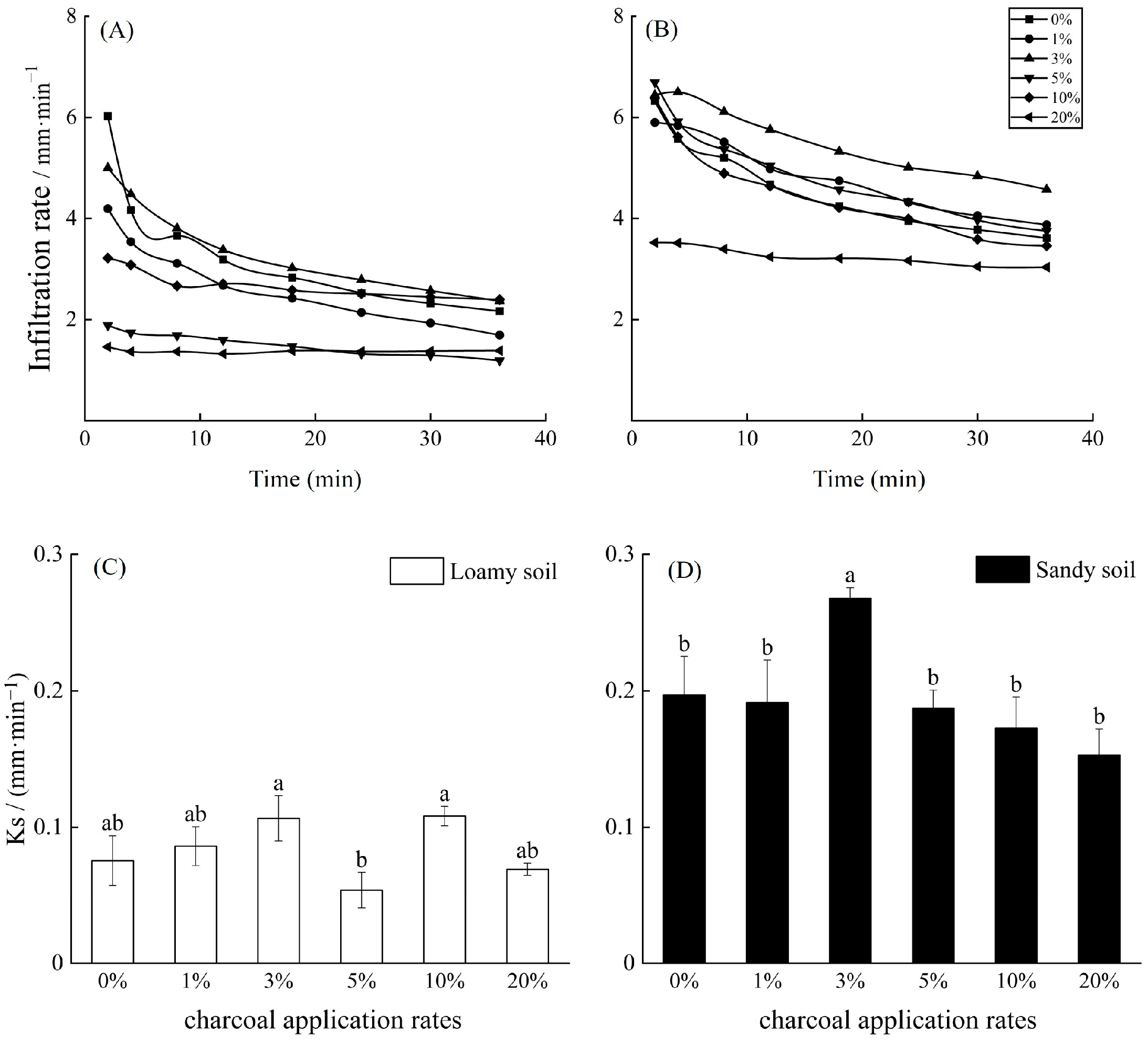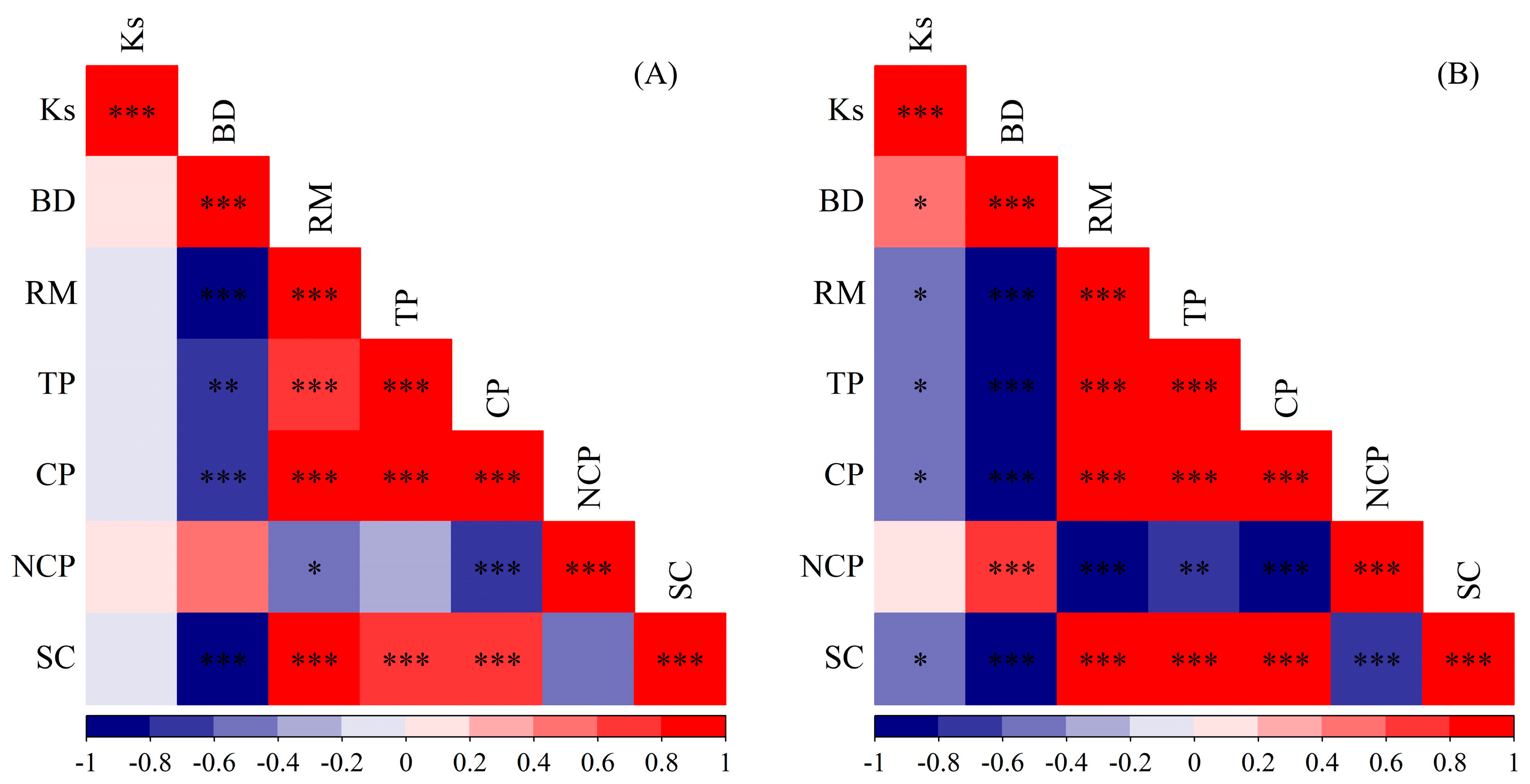Naturally Deposited Charcoal Enhances Water Retention Capacity of Subtropical Forest Soils
Abstract
1. Introduction
2. Materials and Methods
2.1. Charcoal and Soil Preparation
2.2. Experiment Design and Treatment
2.3. Statistical Analysis
3. Results
3.1. Soil Bulk Density and Porosity
3.2. Soil Residual Moisture After Free Drainage and Saturated Capacity
3.3. Soil Saturated Infiltration Rate and Hydraulic Conductivity
3.4. Relationships Between Soil Saturated Hydraulic Conductivity and Soil Characteristics
4. Discussion
4.1. Effects of Fire-Derived Charcoal on Soil Water Retention Capacity
4.2. Effect of Fire-Derived Charcoal on Soil’s Saturated Hydraulic Conductivity
5. Conclusions
Author Contributions
Funding
Data Availability Statement
Acknowledgments
Conflicts of Interest
References
- Leys, B.A.; Marlon, J.R.; Umbanhowar, C.; Vannière, B. Global fire history of grassland biomes. Ecol. Evol. 2018, 8, 8831–8852. [Google Scholar] [CrossRef] [PubMed]
- Neary, D.G. Forest Soil Disturbance: Implications of Factors Contributing to the Wildland Fire Nexus. Soil Sci. Soc. Am. J. 2019, 83, S228–S243. [Google Scholar] [CrossRef]
- Mansoor, S.; Farooq, I.; Kachroo, M.M.; Mahmoud, A.E.D.; Fawzy, M.; Popescu, S.M.; Alyemeni, M.; Sonne, C.; Rinklebe, J.; Ahmad, P. Elevation in wildfire frequencies with respect to the climate change. J. Environ. Manag. 2022, 301, 113769. [Google Scholar] [CrossRef] [PubMed]
- Turco, M.; Abatzoglou, J.T.; Herrera, S.; Zhuang, Y.; Jerez, S.; Lucas, D.D.; AghaKouchak, A.; Cvijanovic, I. Anthropogenic climate change impacts exacerbate summer forest fires in California. Proc. Natl. Acad. Sci. USA 2023, 120, e2213815120. [Google Scholar] [CrossRef]
- Tiedemann, A.R.; Klemmedson, J.O.; Bull, E.L. Solution of forest health problems with prescribed fire: Are forest productivity and wildlife at risk? For. Ecol. Manag. 2000, 127, 1–18. [Google Scholar] [CrossRef]
- Fernandes, P.M.; Botelho, H.S. A review of prescribed burning effectiveness in fire hazard reduction. Int. J. Wildland Fire 2003, 12, 117–128. [Google Scholar] [CrossRef]
- Wang, Y.; Zheng, J.; Liu, X.; Yan, Q.; Hu, Y. Short-term impact of fire-deposited charcoal on soil microbial community abundance and composition in a subtropical plantation in China. Geoderma 2020, 359, 113992. [Google Scholar] [CrossRef]
- Fultz, L.M.; Moore-Kucera, J.; Dathe, J.; Davinic, M.; Perry, G.; Wester, D.; Schwilk, D.W.; Rideout-Hanzak, S. Forest wildfire and grassland prescribed fire effects on soil biogeochemical processes and microbial communities: Two case studies in the semi-arid Southwest. Appl. Soil Ecol. 2016, 99, 118–128. [Google Scholar] [CrossRef]
- Alcañiz, M.; Outeiro, L.; Francos, M.; Úbeda, X. Effects of prescribed fires on soil properties: A review. Sci. Total Environ. 2018, 613, 944–957. [Google Scholar] [CrossRef]
- Ebel, B.A.; Moody, J.A. Synthesis of soil-hydraulic properties and infiltration timescales in wildfire-affected soils. Hydrol. Process. 2017, 31, 324–340. [Google Scholar] [CrossRef]
- Moragues-Saitua, L.; Arias-González, A.; Gartzia-Bengoetxea, N. Effects of biochar and wood ash on soil hydraulic properties: A field experiment involving contrasting temperate soils. Geoderma 2017, 305, 144–152. [Google Scholar] [CrossRef]
- Lim, T.; Spokas, K.; Feyereisen, G.; Novak, J. Predicting the impact of biochar additions on soil hydraulic properties. Chemosphere 2016, 142, 136–144. [Google Scholar] [CrossRef] [PubMed]
- Toková, L.; Igaz, D.; Horák, J.; Aydin, E. Effect of Biochar Application and Re-Application on Soil Bulk Density, Porosity, Saturated Hydraulic Conductivity, Water Content and Soil Water Availability in a Silty Loam Haplic Luvisol. Agronomy 2020, 10, 1005. [Google Scholar] [CrossRef]
- Villagra-Mendoza, K.; Horn, R. Effect of biochar on the unsaturated hydraulic conductivity of two amended soils. Int. Agrophys. 2018, 32, 373–378. [Google Scholar] [CrossRef]
- Quigley, K.M.; Kolka, R.; Sturtevant, B.R.; Dickinson, M.B.; Kern, C.C.; Miesel, J.R. Restoring open canopy pine barrens from the ground up: Repeated burns correspond with increased soil hydraulic conductivity. Sci. Total Environ. 2021, 767, 144258. [Google Scholar] [CrossRef]
- Savage, S.M. Mechanism of fire-induced water repellency in soil. Soil Sci. Soc. Am. J. 1974, 38, 1213–1215. [Google Scholar] [CrossRef]
- Certini, G. Effects of fire on properties of forest soils: A review. Oecologia 2005, 143, 1–10. [Google Scholar] [CrossRef]
- DeBano, L. The role of fire and soil heating on water repellency in wildland environments: A review. J. Hydrol. 2000, 231, 195–206. [Google Scholar] [CrossRef]
- MacDonald, L.H.; Huffman, E.L. Post-fire Soil Water Repellency: Persistence and soil moisture thresholds. Soil Sci. Soc. Am. J. 2004, 68, 1729–1734. [Google Scholar] [CrossRef]
- Alewell, C.; Ringeval, B.; Ballabio, C.; Robinson, D.A.; Panagos, P.; Borrelli, P. Global phosphorus shortage will be aggravated by soil erosion. Nat. Commun. 2020, 11, 4546. [Google Scholar] [CrossRef]
- Liu, B.; Xie, Y.; Li, Z.; Liang, Y.; Zhang, W.; Fu, S.; Yin, S.; Wei, X.; Zhang, K.; Wang, Z.; et al. The assessment of soil loss by water erosion in China. Int. Soil Water Conserv. Res. 2020, 8, 430–439. [Google Scholar] [CrossRef]
- Chen, J.; Xiao, H.; Li, Z.; Liu, C.; Ning, K.; Tang, C. How effective are soil and water conservation measures (SWCMs) in reducing soil and water losses in the red soil hilly region of China? A meta-analysis of field plot data. Sci. Total Environ. 2020, 735, 139517. [Google Scholar] [CrossRef] [PubMed]
- Lu, J.; Luo, Y.; Huang, J.; Hou, B.; Wang, B.; Ogino, K.; Zhao, J.; Si, H. Evaluating the effects of biochar on the hydraulic properties of acidified soil in China. J. Soils Sediments 2023, 23, 223–231. [Google Scholar] [CrossRef]
- Makoto, K.; Koike, T. Charcoal ecology: Its function as a hub for plant succession and soil nutrient cycling in boreal forests. Ecol. Res. 2021, 36, 4–12. [Google Scholar] [CrossRef]
- Bhat, S.A.; Kuriqi, A.; Dar, M.U.D.; Bhat, O.; Sammen, S.S.; Islam, A.R.M.T.; Elbeltagi, A.; Shah, O.; Ai-Ansari, N.; Ali, R.; et al. Application of Biochar for Improving Physical, Chemical, and Hydrological Soil Properties: A Systematic Review. Sustainability 2022, 14, 11104. [Google Scholar] [CrossRef]
- Brodowski, S.; John, B.; Flessa, H.; Amelung, W. Aggregate-occluded black carbon in soil. Eur. J. Soil Sci. 2006, 57, 539–546. [Google Scholar] [CrossRef]
- Herath, H.; Camps-Arbestain, M.; Hedley, M. Effect of biochar on soil physical properties in two contrasting soils: An Alfisol and an Andisol. Geoderma 2013, 209, 188–197. [Google Scholar] [CrossRef]
- Edeh, I.G.; Mašek, O. The role of biochar particle size and hydrophobicity in improving soil hydraulic properties. Eur. J. Soil Sci. 2021, 73, e13138. [Google Scholar] [CrossRef]
- Laird, D.A.; Fleming, P.; Davis, D.D.; Horton, R.; Wang, B.; Karlen, D.L. Impact of biochar amendments on the quality of a typical Midwestern agricultural soil. Geoderma 2010, 158, 443–449. [Google Scholar] [CrossRef]
- Jeffery, S.; Meinders, M.B.; Stoof, C.R.; Bezemer, T.M.; van de Voorde, T.F.; Mommer, L.; van Groenigen, J.W. Biochar application does not improve the soil hydrological function of a sandy soil. Geoderma 2015, 251–252, 47–54. [Google Scholar] [CrossRef]
- Li, S.; Zhang, Y.; Yan, W.; Shangguan, Z. Effect of biochar application method on nitrogen leaching and hydraulic conductivity in a silty clay soil. Soil Tillage Res. 2018, 183, 100–108. [Google Scholar] [CrossRef]
- Zhou, H.; Fang, H.; Zhang, Q.; Wang, Q.; Chen, C.; Mooney, S.J.; Peng, X.; Du, Z. Biochar enhances soil hydraulic function but not soil aggregation in a sandy loam. Eur. J. Soil Sci. 2019, 70, 291–300. [Google Scholar] [CrossRef]
- Rabbi, S.M.; Minasny, B.; Salami, S.T.; McBratney, A.B.; Young, I.M. Greater, but not necessarily better: The influence of biochar on soil hydraulic properties. Eur. J. Soil Sci. 2021, 72, 2033–2048. [Google Scholar] [CrossRef]
- Abyaneh, H.Z.; Khodabandehlo, Z.; Bayat, H.; Jovzi, M. The Effect of a Superabsorbent and Biochar on Some Physical and Hydraulic Properties of Two Arable Sandy Loam and Clay Loam Soils. J. Soil Sci. Plant Nutr. 2022, 22, 2557–2569. [Google Scholar] [CrossRef]
- Qiu, D.; Xu, R.; Wu, C.; Mu, X.; Zhao, G.; Gao, P. Vegetation restoration improves soil hydrological properties by regulating soil physicochemical properties in the Loess Plateau, China. J. Hydrol. 2022, 609, 127730. [Google Scholar] [CrossRef]
- Karer, J.; Wimmer, B.; Zehetner, F.; Kloss, S.; Soja, G. Biochar application to temperate soils: Effects on nutrient uptake and crop yield under field conditions. Agric. Food Sci. 2013, 22, 390–403. [Google Scholar] [CrossRef]
- Koide, R.T.; Nguyen, B.T.; Skinner, R.H.; Dell, C.J.; Peoples, M.S.; Adler, P.R.; Drohan, P.J. Biochar amendment of soil improves resilience to climate change. GCB Bioenergy 2015, 7, 1084–1091. [Google Scholar] [CrossRef]
- Xu, G.; Sun, J.; Shao, H.; Chang, S.X. Biochar had effects on phosphorus sorption and desorption in three soils with differing acidity. Ecol. Eng. 2014, 62, 54–60. [Google Scholar] [CrossRef]
- Peake, L.R.; Reid, B.J.; Tang, X. Quantifying the influence of biochar on the physical and hydrological properties of dissimilar soils. Geoderma 2014, 235–236, 182–190. [Google Scholar] [CrossRef]
- Fu, G.; Qiu, X.; Xu, X.; Zhang, W.; Zang, F.; Zhao, C. The role of biochar particle size and application rate in promoting the hydraulic and physical properties of sandy desert soil. CATENA 2021, 207, 105607. [Google Scholar] [CrossRef]
- Wang, Y.; Villamil, M.B.; Davidson, P.C.; Akdeniz, N. A meta-analysis on biochar’s effects on soil water properties - new insights and future research challenges. Sci. Total Environ. 2020, 685, 741–752. [Google Scholar] [CrossRef] [PubMed]
- Kang, M.W.; Yibeltal, M.; Kim, Y.H.; Oh, S.J.; Lee, J.C.; Kwon, E.E.; Lee, S.S. Enhancement of soil physical properties and soil water retention with biochar-based soil amendments. Sci. Total Environ. 2022, 836, 155746. [Google Scholar] [CrossRef] [PubMed]
- Lehmann, J.; Joseph, S. Biochar for Environmental Management, 1st ed.; Earthscan: London, UK, 2009. [Google Scholar]
- Cheng, C.-H.; Lehmann, J.; Thies, J.E.; Burton, S.D.; Engelhard, M.H. Oxidation of black carbon by biotic and abiotic processes. Org. Geochem. 2006, 37, 1477–1488. [Google Scholar] [CrossRef]
- Zhang, J.; Chen, Q.; You, C. Biochar Effect on Water Evaporation and Hydraulic Conductivity in Sandy Soil. Pedosphere 2016, 26, 265–272. [Google Scholar] [CrossRef]
- Alghamdi, A.G.; Alkhasha, A.; Ibrahim, H.M. Effect of biochar particle size on water retention and availability in a sandy loam soil. J. Saudi Chem. Soc. 2020, 24, 1042–1050. [Google Scholar] [CrossRef]
- Ren, X.; Wang, F.; Zhang, P.; Guo, J.; Sun, H. Aging effect of minerals on biochar properties and sorption capacities for atrazine and phenanthrene. Chemosphere 2018, 206, 51–58. [Google Scholar] [CrossRef]
- Major, J.; Rondon, M.; Molina, D.; Riha, S.J.; Lehmann, J. Nutrient Leaching in a Colombian Savanna Oxisol Amended with Biochar. J. Environ. Qual. 2012, 41, 1076–1086. [Google Scholar] [CrossRef]
- Głąb, T.; Palmowska, J.; Zaleski, T.; Gondek, K. Effect of biochar application on soil hydrological properties and physical quality of sandy soil. Geoderma 2016, 281, 11–20. [Google Scholar] [CrossRef]





| Soil Type | Total Carbon (g·kg−1) | Total Nitrogen (g·kg−1) | Granular Composition (%) | pH | ||
|---|---|---|---|---|---|---|
| Clay | Sand | Silt | ||||
| Loamy soil | 22.98 | 1.27 | 24.67 | 40.23 | 35.10 | 4.96 |
| Sandy soil | 4.18 | 0.55 | 2.74 | 92.39 | 4.87 | 5.57 |
| Factors | BD | TP | CP | NCP | RM | SC | Ks |
|---|---|---|---|---|---|---|---|
| Charcoal (C) | *** | *** | *** | *** | *** | *** | *** |
| Soil type (S) | *** | *** | *** | *** | *** | *** | *** |
| C × S | *** | *** | *** | NS | *** | *** | ** |
Disclaimer/Publisher’s Note: The statements, opinions and data contained in all publications are solely those of the individual author(s) and contributor(s) and not of MDPI and/or the editor(s). MDPI and/or the editor(s) disclaim responsibility for any injury to people or property resulting from any ideas, methods, instructions or products referred to in the content. |
© 2024 by the authors. Licensee MDPI, Basel, Switzerland. This article is an open access article distributed under the terms and conditions of the Creative Commons Attribution (CC BY) license (https://creativecommons.org/licenses/by/4.0/).
Share and Cite
Cheng, L.; Wang, K.; Yao, Z.; Liu, X.; Zhao, D.; Wang, Y. Naturally Deposited Charcoal Enhances Water Retention Capacity of Subtropical Forest Soils. Forests 2024, 15, 1939. https://doi.org/10.3390/f15111939
Cheng L, Wang K, Yao Z, Liu X, Zhao D, Wang Y. Naturally Deposited Charcoal Enhances Water Retention Capacity of Subtropical Forest Soils. Forests. 2024; 15(11):1939. https://doi.org/10.3390/f15111939
Chicago/Turabian StyleCheng, Liutao, Kuan Wang, Zhi Yao, Xian Liu, Dan Zhao, and Yuzhe Wang. 2024. "Naturally Deposited Charcoal Enhances Water Retention Capacity of Subtropical Forest Soils" Forests 15, no. 11: 1939. https://doi.org/10.3390/f15111939
APA StyleCheng, L., Wang, K., Yao, Z., Liu, X., Zhao, D., & Wang, Y. (2024). Naturally Deposited Charcoal Enhances Water Retention Capacity of Subtropical Forest Soils. Forests, 15(11), 1939. https://doi.org/10.3390/f15111939






